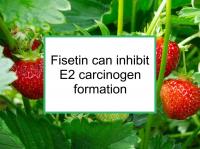Fisetin is a flavonol, a type of flavonoid, which are pigments found in a wide variety of plants. Flavonoids can be divided into six major groups: flavones, flavonols, anthocyanins, isoflavones, flavan-3-ols, and flavanones. The best known flavonols are quercetin and kaempferol, which are well-studied.
Diets abundant in quercetin and kaempferol have been found to be associated with reduced breast cancer risk. Now a new study has demonstrated that fisetin may inhibit the formation of a carcinogenic compound from estradiol (E2, the most important estrogen).
Food sources of fisetin
Fisetin is most abundant in strawberries, apples and persimmons. Onions, grapes, and kiwifruit are good sources. Fisetin is also found in peaches, cucumbers, tomatoes and mangoes.
Latest research shows how fisetin inhibits estrogen metabolism
The study referenced at the beginning of this news story was designed to investigate the influence of fisetin on the metabolism of 17β-estradiol (E2). E2 can be converted to the carcinogenic compound 4-hydroxy-E2 (4-OHE2). This process is mediated by cytochrome P450 (CYP) 1B1. In other words, the CYP1B1 gene provides instructions for producing an enzyme that is a member of the cytochrome P450 family of enzymes. Cytochrome P450 enzymes metabolize a wide variety of compounds, including E2, many drugs, and various toxic compounds. CYP1B1 is highly expressed in tissues very responsive to estrogen, such as the breasts, ovaries, and uterus.
In the study, the authors demonstrated that fisetin inhibited CYP1B1 activity. In fact, the inhibition caused by fisetin was stronger that that of flavone. (Flavones do not have the hydroxyl backbone of flavonols such as fisetin; the main flavones are luteolin and apigenin). Both fisetin and flavone exhibited mixed inhibition. Based on this and other analyses, the authors determined that fisetin may inhibit the formation of carcinogenic 4-OHE2 from E2.
The authors conclude that these results reveal an anti-cancer mechanism of fisetin. The relationship the authors uncovered between the structure of flavonoids and the inhibition CYP1B1 can be useful in developing new drugs for cancer treatment and prevention.
